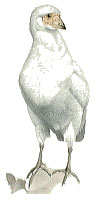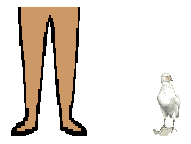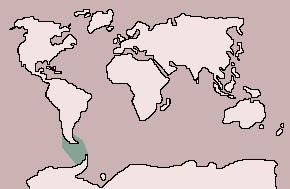Snowy Sheathbill

| Class: Aves: Birds |
Diet: Fish, young
birds, seaweed, carrion |
| Order:
Charadriiformes: Auks, Waders, Laris |
| Size:
39 cm (15 1/4 in) |
| Family: Chionididae:
Sheathbills |
Conservation Status:
Non-threatened |
| Scientific Name: Chionis
alba |
Habitat: coasts |
| Range:
Subantarctic islands of the southern Atlantic Ocean, extending to Graham
Land and southern South America when not breeding |
 Snowy
sheathbills are gregarious and pugnacious birds, and except during the
breeding season, they live in small flocks, feeding together and often
fighting. Although they fly well and will make long journeys, even over
sea, they spend most of their time on the ground. They swim well although
their feet have only rudimentary webs. Sheathbills are avid scavengers
and haunt seal and penguin colonies to seize afterbirths or weak young.
They also search the shore for all kinds of fish, invertebrates, carcasses
and almost any other debris that they can eat. They consume quantities
of seaweed for the invertebrates that it harbors. Sheathbills nest
in isolated pairs in a crevice or among rocks. The 2 or 3 eggs are laid
on feathers, seaweed and other soft material. Both male and female incubate
the eggs for a total of 28 days, but it seems as if only 1 chick is actually
reared as a general rule. In winter, sheathbills in the extreme south
of the range migrate north, but those on subantarctic islands usually remain
there. The other species in this family, the black-billed sheathbill, C.
minor, occurs in the subantarctic sector of the Indian Ocean. Snowy
sheathbills are gregarious and pugnacious birds, and except during the
breeding season, they live in small flocks, feeding together and often
fighting. Although they fly well and will make long journeys, even over
sea, they spend most of their time on the ground. They swim well although
their feet have only rudimentary webs. Sheathbills are avid scavengers
and haunt seal and penguin colonies to seize afterbirths or weak young.
They also search the shore for all kinds of fish, invertebrates, carcasses
and almost any other debris that they can eat. They consume quantities
of seaweed for the invertebrates that it harbors. Sheathbills nest
in isolated pairs in a crevice or among rocks. The 2 or 3 eggs are laid
on feathers, seaweed and other soft material. Both male and female incubate
the eggs for a total of 28 days, but it seems as if only 1 chick is actually
reared as a general rule. In winter, sheathbills in the extreme south
of the range migrate north, but those on subantarctic islands usually remain
there. The other species in this family, the black-billed sheathbill, C.
minor, occurs in the subantarctic sector of the Indian Ocean.

  
|
